

Wide coverage, high reliability, easy deployment, and low power consumption: Realtek Bluetooth Mesh empowers a new ecosystem for smart IoT.
Bluetooth Mesh Protocol is a decentralized many-to-many communication protocol built on Bluetooth Low Energy (BLE) technology, specifically designed for large-scale device networking. It adopts a self-organizing network architecture and overcomes traditional point-to-point communication limitations through a relay forwarding mechanism, making it ideal for high-density, low-power scenarios such as smart homes and industrial automation. Its core advantages include:
- No Central Hub Required: Utilizes multi-path broadcast transmission, where nodes autonomously relay messages, eliminating single-point failure risks and ensuring high network reliability.
- Relay Forwarding Mechanism: Employs dynamic Time-to-Live (TTL) control to limit hop counts, with relay nodes forwarding messages step-by-step to achieve wide-area network coverage.
- Direct Mobile Connectivity: Enables seamless interaction between smartphones and the Mesh network via Proxy Nodes.
- Low-Power Optimization: Supports Friend-Low Power node collaboration, allowing sensor-class devices to operate in sleep mode for years.
- Robust Security: Layered encryption (network layer + application layer); Dynamic key refresh to resist man-in-the-middle attacks, Sequence number mechanisms to prevent replay attacks.
Application Scenario
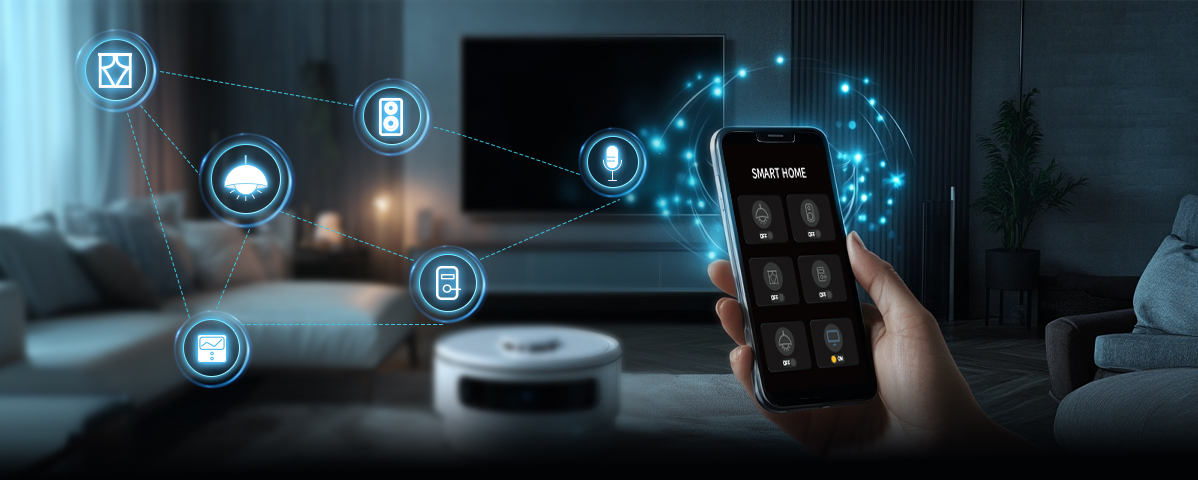
The Bluetooth Mesh network enables efficient device interaction in smart homes, enhancing the user experience. Through the Bluetooth Mesh network, users can operate devices and manage lighting, security systems, and environmental control devices in real-time using a smartphone or voice-controlled gateway.

The relay mechanism of the Bluetooth Mesh network can cover complex factory environments and support networking with tens of thousands of nodes. This network can transmit device data to the control center in real-time, ensuring communication reliability through flooding and directed forwarding mechanisms, thereby enabling production line automation and predictive maintenance.

Users can easily control thousands of lights in a mall or parking lot through the Bluetooth Mesh network. By utilizing the multicast address feature of the Bluetooth Mesh network, users can also achieve zoned management of the lighting. This lighting system enables dynamic zonal dimming and energy consumption monitoring through the Bluetooth Mesh network, and it can also perform remote bulk firmware upgrades, thereby reducing wiring costs and operational complexity.

The Bluetooth Mesh network enables efficient device interaction in smart homes, enhancing the user experience. Through the Bluetooth Mesh network, users can operate devices and manage lighting, security systems, and environmental control devices in real-time using a smartphone or voice-controlled gateway.

The relay mechanism of the Bluetooth Mesh network can cover complex factory environments and support networking with tens of thousands of nodes. This network can transmit device data to the control center in real-time, ensuring communication reliability through flooding and directed forwarding mechanisms, thereby enabling production line automation and predictive maintenance.

Users can easily control thousands of lights in a mall or parking lot through the Bluetooth Mesh network. By utilizing the multicast address feature of the Bluetooth Mesh network, users can also achieve zoned management of the lighting. This lighting system enables dynamic zonal dimming and energy consumption monitoring through the Bluetooth Mesh network, and it can also perform remote bulk firmware upgrades, thereby reducing wiring costs and operational complexity.
Basic Working Principle
Bluetooth Mesh Protocol adopts a layered architecture to enable efficient networking and communication. Its main components and functions are as follows:
Bearer Layer: Implements basic data transmission between nodes via BLE broadcast channels and GATT connections.
Network Layer: Defines device addresses (unicast/multicast/broadcast) and message forwarding logic. Relay nodes propagate messages hop-by-hop (directed/flooding) based on TTL values, automatically expanding network coverage.
Transport Layer: Splits and reassembles large data packets, isolating application data through AppKey.
Access Layer: Standardizes data formats and operational commands (e.g., on/off, dimming), binding device states to message types.
Model Layer: Predefines standardized behavior models (e.g., lighting/sensors) to describe device functionalities and interaction logic, supporting rapid development.
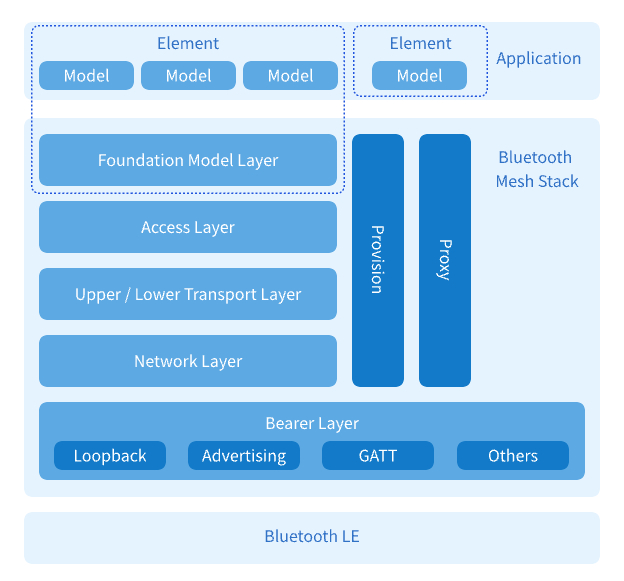
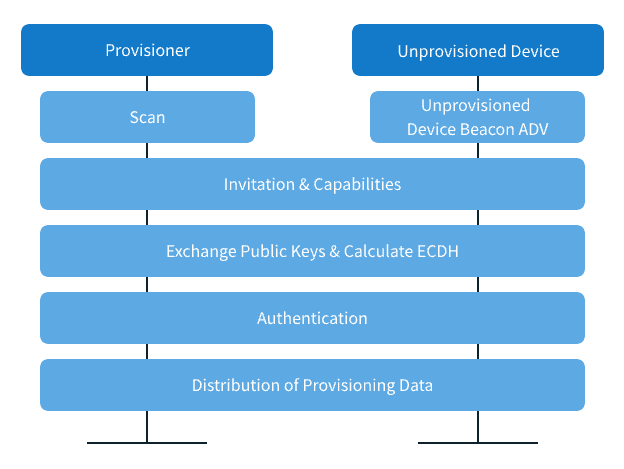
Provisioning is the critical process of securely adding new devices to a Mesh network. Through Advertising broadcasts or GATT connections, devices interact with a provisioner (e.g., a smartphone or gateway) to ensure network scalability and security. The entire process consists of three phases:
1. Device Discovery: Unprovisioned devices broadcast their presence via beacons. The provisioner scans and selects the target device, inviting it to join the network.
2. Authentication: The device and provisioner establish a secure channel using the ECDH (Elliptic Curve Diffie-Hellman) algorithm. The device generates and exchanges a public key with the provisioner to prevent man-in-the-middle attacks.
3. Key Distribution: The provisioner assigns a network key (NetKey), the current IV Index value, and a unicast address to the device, enabling it to join the network.
During this process, devices exchange essential information and negotiate capabilities to establish reliable connections. Each new device receives a unique identity, allowing the network to dynamically adjust when discovering new devices, optimize overall efficiency, and support large-scale connectivity for smart buildings and smart homes.
The Bluetooth Mesh Proxy feature enables traditional Bluetooth devices (e.g., smartphones and tablets) to interact with a Bluetooth Mesh network, allowing non-Mesh devices to access and manage network nodes.
Nodes supporting Bluetooth Mesh Proxy act as bridges, facilitating communication between Bluetooth Low Energy (BLE) mode and Mesh mode. By establishing BLE connections, traditional Bluetooth devices can interact with Proxy nodes and utilize Mesh Proxy GATT services to send control commands. The Proxy nodes then convert and relay these commands to target nodes within the Mesh network.
This mechanism not only simplifies the integration of devices with the Mesh network but also allows users to manage and monitor the entire network using existing smart devices, enhancing the convenience and functionality of Bluetooth Mesh networks.
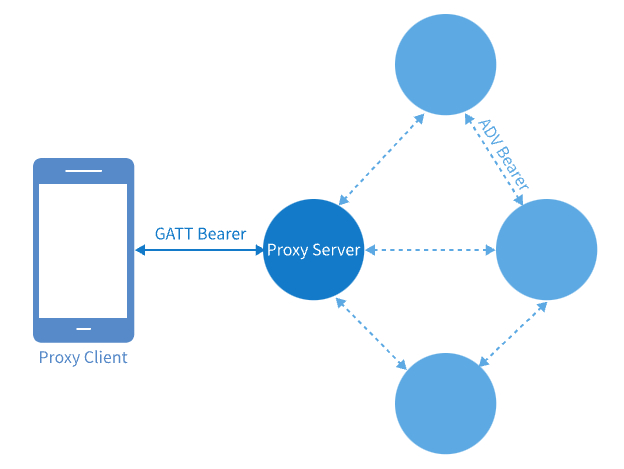

The Bluetooth Mesh Model is the core specification defining device functionalities and interaction methods. It is divided into two categories: standard models (defined by the Bluetooth SIG to ensure cross-vendor compatibility) and custom models (allowing vendors to extend specialized features). Each model represents a specific function, such as lighting control or environmental monitoring.
Devices achieve dynamic collaboration through client-server architecture and publish-subscribe patterns:
1. Command Interaction: A client (e.g., a mobile app) sends Set/Get commands, and the server (e.g., a light) responds with Status updates.
2. Multicast Communication: Devices publish data to a group address, and devices subscribed to that address automatically trigger responses.
3. Smart Automation:
- State binding: Linking parameters across models.
- Scene presets: Triggering multi-device state combinations via the Scene Server with a single command.
Specification Parameters

- Network capacity: A single network supports up to 32,767 nodes
- Message forwarding: Managed flooding and directed forwarding
- Security features: AES-CCM data encryption, ECDH-encrypted network provisioning, sequence number anti-replay attack
- Device compatibility: Supports access from devices like smartphones or tablets
- Low-latency response: 200+ nodes responding simultaneously, latency <100ms
- High success rate: Full Scan, control success rate >99%
- High stability: Long-term stable operation in complex networks

- Relay
- Proxy
- Low Power
- Friend

- Enhanced Provisioning Authentication
- Remote Provisioning
- Private Beacons
- Directed Forwarding
- Subnet Bridge
- Binary Large Object Transfer
- Device Firmware Update

- Generic Models
- Sensor Models
- Time and Scene Models
- Lighting Models
- NLC Profiles
Advantages

The Mesh protocol stack, validated through real-world projects and refined with targeted optimizations, delivers exceptional communication efficiency, reliability, and stability. It supports simultaneous ADV broadcasting and GATT connections, meeting the high-efficiency communication demands of large-scale applications.

The solution has been integrated with multiple IoT smart ecosystem platforms, achieved mass production shipments, and is mature and stable.

Offers a comprehensive solution covering gateway, device, and mobile app platforms. With proven expertise across all three terminal domains, it accelerates the rapid deployment of diverse projects.

A fully functional Mesh SDK development kit that supports the development of Provisioner and Device in Mesh networks, and provides rich product prototype projects to help developers easily build and expand various device products.

A comprehensive mobile SDK (supporting iOS/Android) with full-featured device management and control capabilities, featuring an intuitive user interface and scalable architecture to help developers quickly create stable and high-efficiency mobile applications.
Product Applications
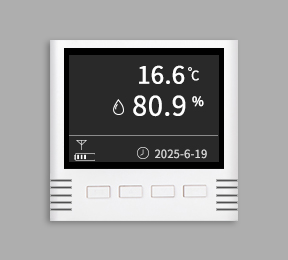
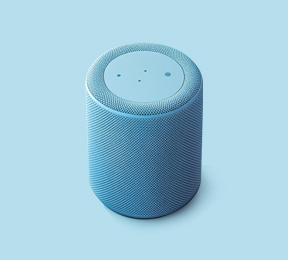

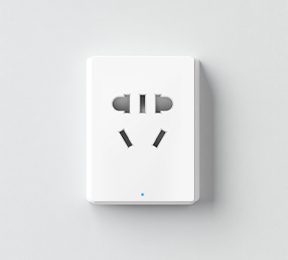

Implementation Guide
a) Select appropriate Bluetooth Mesh roles based on product functions (e.g., lighting, sensors, gateway).
b) Complete hardware selection using the reference selection table.
a) Purchase official evaluation boards from online stores.
b) Download SDK toolkits (including Mesh protocol stack, basic sample code, and configuration tools) via the developer portal.
a) Network configuration: Use Provisioning role to complete device onboarding and key distribution.
b) Scenario-based development: Implement device functions based on Model specifications (e.g., dimming control with Lighting-related Models).
a) Functional verification: Message transmission success rate testing and multi-node stress testing.
b) Certification preparation: Refer to Bluetooth Qualification.
a) Use mass production tool for device programming.
b) Integrate OTA upgrade functionality and use OTA tools for future maintenance.
Recommended Hardware
Part Number | RTL8762CMF | RTL8762EMF | RTL8762EMF-VS | RTL8762GKH |
|---|---|---|---|---|
MCU | CM4F 40M | CM0+ 40M | CM0+ 40M | CM55 125MHz |
Flash | 512KB | 512KB | 1024KB | 1024KB |
RAM | 160KB | 104KB | 104KB | 384KB |
Tx/Rx | 7.9mA/7.3mA | 5.9mA/5.3mA | 5.9mA/5.3mA | 6.9mA/5.6mA |
PWM | 8 | 6 | 6 | 10 |
UART | 3 | 2 | 2 | 6 |
Operating temperature | -40 ~ 105°C | -40 ~ 85°C | -40 ~ 85°C | -40 ~ 85°C |
Package (mm) | QFN40, 5x5 | QFN40, 5x5 | QFN40, 5x5 | QFN48, 6x6 |
Bluetooth LE Qualification | Core 5.4 | Core 5.4 | Core 5.4 | Core 5.4 |
Bluetooth Mesh Qualification | Mesh 1.1 | Mesh 1.1 | Mesh 1.1 | Mesh 1.1 |
Features | / | / | / |



 苏公网安备32059002006558号
苏公网安备32059002006558号